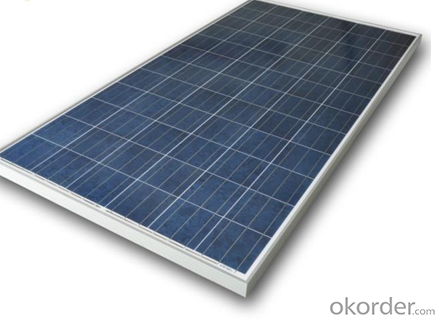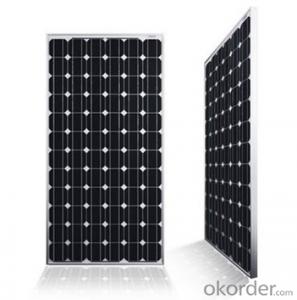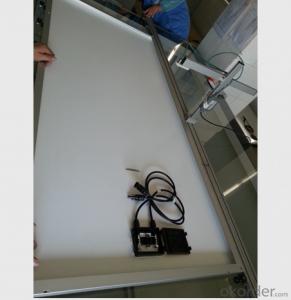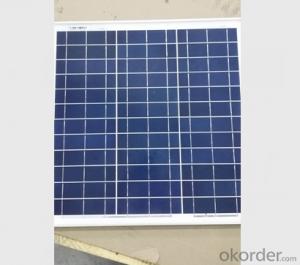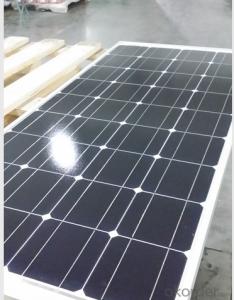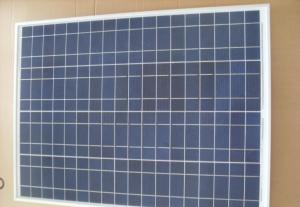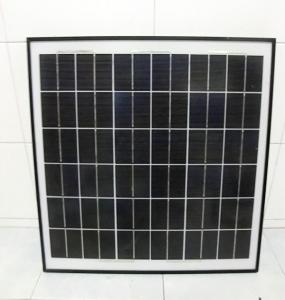SMUD Solar Panels Polycrystalline CNPV-310W High Performance 72 Cell
- Loading Port:
- Shanghai
- Payment Terms:
- TT OR LC
- Min Order Qty:
- 25 pc
- Supply Capability:
- 100000 pc/month
OKorder Service Pledge
OKorder Financial Service
You Might Also Like
Product Description:
Solar Polycrystalline Series Panels
Introduction of Solar Polycrystalline Series Panels
CNBM Solar photovoltaic (PV) Panel is designed for large electrical power requirements. It is the optimal choice for both on-grid and off-grid power systems. CNBM Solar panel offers high performance of power per square foot of solar array. Monocrystalline silicon(c-Si): often made using the Czochralski process. Single-crystal wafer cells tend to be expensive, and because they are cut from cylindrical ingots, do not completely cover a square solar cell module without a substantial waste of refined silicon. Hence most c-Si panels have uncovered gaps at the four corners of the cells.
Standard Test Conditions of Solar Polycrystalline Series Panels
The opto-electrical specifications shown below are stabilized values being measured at Standard Test Conditions, Irradiance: 1000W/m2, Spectrum: AM1.5 at 25°C, The info below is subject to manufacturing tolerances. Where appropriate minutes of measurement are available and are used for the dimensioning of the installation.
Advantages of Solar Polycrystalline Series Panels
• Solar performance guarantees for 25 years
• 12 years guarantee for workmanship
• Timeliness of delivery
Characteristics of Solar Polycrystalline Series Panels
Max Power Voltage Vmp (V) | 37V |
Max Power Current Imp (A) | 8.4A |
Open Circuit Voltage Voc (V) | 45.8V |
Short Circuit Current Isc (A) | 8.95A |
Max Power Pm (W) | 310W |
Temperature Coefficient of Cells
NOCT | 47℃±2℃ |
Temperature Coefficients of Isc (%/℃) | 0.064 |
Temperature Coefficients of Voc (%/℃) | -0.33 |
Temperature Coefficients of Pmp (%/℃) | -0.45 |
Mechanical Data Solar Polyocrystalline Series
Power | 310W |
Dimension | 1965×992×35mm |
Weight | 22kg |
Tolerance | ±3% |
The dimension of the modules can be changed according to the demand of clients
Limits
Operating Temperature | –40 °C to +85°C |
Storage Temperature | –40 °C to +85°C |
Max System Voltage | 700V |
Guarantee Solar Polyocrystalline Series Panels
Products Guarantee | 12 yrs free from defects in materials and workmanship |
Performance Guarantee | No less than 90% within 10yrs and no less than 80% within 25yrs |
Certificates | UL, IEC, ISO, TUV, CE |
The Examination of Solar Polyocrystalline Series Panels
FAQ
We have organized several common questions for our clients,may help you sincerely:
①What price for each watt?
It depends on the quantity, delivery date and payment terms,
②What is your size for each module? Can you tell me the Parameter of your module?
We have different series of panels in different output, both c-Si and a-Si. Please take the specification sheet for your reference.
③Can you provide the peripheral products of the solar panels, such as the battery, controller, and inverter? If so, can you tell me how do they match each other?
Yes, we can, we have two companies for solar region, one is CNBM International, the other is CNBM engineering Co.
We can provide you not only the solar module but also the off grid solar system, we can also provide you service with on grid plant.
④What is your warranty system?
Our product performance guarantees for 25 years
• 12 years guarantee for workmanship
• Timeliness of delivery
• Quality Products certified (TÜV, UL, CE, ISO)
⑤How do you pack your products?
We have rich experience on how to pack the panels to make sure the safety on shipment when it arrives at the destination.
⑥ Can you do OEM for us?
Yes, we can.
⑦How long can we receive the product after purchase?
In the purchase of product within three working days, We will arrange the factory delivery as soon as possible. The pecific time of receiving is related to the state and position of customers.Commonly 7 to 10 working days can be served.
- Q: I am doing a report about solar power and I need to know what determines the amount of electricity produced?example: exposure to sun, angle of panel, qualityplease tell me as much as you canmuch appreciated
- It depends on what you mean by amount of electricity. Normally that would mean the total energy produced over a given period. In that case, the main factors are ) Efficiency of the solar cells 2) Total irradiation received: incident radiation density times the solar panel area, and the angle of the incident radiation. Item ) is determined by the materials and method of construction of the solar cells Item 2) depends on the location of the panel, both on earth's surface (latitude), time of year, and how the panel is oriented with respect to the horizontal. Altitude of the location can also be a factor. Prevailing weather conditions, number of cloudy days, etc. are important. Independent of these parameters, larger area means more electricity.
- Q: I had an idea for new parabolic solar panels shaped like horseshoes. They can install them outside buildings facing the equator. They could angle them from the ground based on how many degrees latitude the location and rotate them according to seasonal changes. The disadvantage of photovoltaic panels is that they are not all capable of receiving direct sunlight. That is the quintessential reason I believe horseshoe solar panels are more effective than flat rectangular ones. One side could function in the morning; the middle could perform at midday; and the other could operate during the evening. That method seems more sensible than hourly positioning. I'm certain horseshoe panels could save and produce more electricity. A football stadium, shopping mall, or outlet center would be a fantastic place. What do you think?
- The panel's own shadow at different times will defeat the purpose. In addition large areas of expenssive panel will remain idle. Flat panels are the most economical solution.
- Q: Can solar panels be used in areas with extreme temperatures?
- Yes, solar panels can be used in areas with extreme temperatures. However, extreme heat or cold can affect the efficiency and performance of solar panels. It is important to consider the specific temperature conditions and choose appropriate panel materials and installation methods to ensure optimal functioning in such areas.
- Q: im making an energy efficiant house for science class and i need to price the house. im putting solar pannels on the roof and would u please tell me how much they are per like 2 sq. feet of a pannel?
- You are way out of your depth if your report for science class is supposed to be knowledgable. First of all, Solar panels alone will NOT be enough to charge the battery bank, which you don't even mention in your quesiton. Secondly, the only way to have a usable 2 VDC system is to use a wind generator to keep the batteries charged to capacity and, as a plus, they will work at night. A 65 Watt ARCO Solar Panel is about $300 and you need to figure your power by the Wattage Rading for the particular panels . You also need to add in the cost of a 2VDC to 0VAC invertor, monitoring panels etc.... AND... just how big is the ROOF of the house you are planning to use.? This is an area of involved study and it's a bit more than what you are imagining for your high school science class report.
- Q: I'm curious, for those who have had solar panels installed on the rooves of their houses:How much did you pay? How much energy do the panels produce? Did it dramatically cut down on your electricity bill? Was it worth it? Thanks!
- No, but if you have the money, go for it. In Germany, people get a government rebate (much like the Prius rebate our own government offered) and so you see solar panels everywhere. If the Obama administration pushes for a rebate for solar panels, you will see them here in the state. It's the initial cost that puts off most potential solar panel customers. Upkeep isn't too expensive, and they ultimatley pay for themselves. (after about a decade)
- Q: How do solar panels withstand hail or other weather conditions?
- Solar panels are designed to be durable and can withstand hail and other weather conditions due to their sturdy construction and protective materials. The panels are made with tempered glass, which is highly resistant to impacts, including hail. Additionally, the panels are built to withstand high winds, heavy snow loads, and extreme temperatures. This ensures that they can endure harsh weather conditions without being damaged, allowing them to continue generating electricity efficiently.
- Q: Can solar panels be used for powering a museum or cultural institution?
- Yes, solar panels can be used to power a museum or cultural institution. Solar energy is a renewable and sustainable source of power, making it an environmentally-friendly option for museums. By installing solar panels, these institutions can reduce their carbon footprint and lower their energy costs. Additionally, solar power can provide a reliable and consistent source of electricity, ensuring that the museum's operations are not disrupted during power outages or fluctuations in the grid.
- Q: What is the cost of installing solar panels?
- The cost of installing solar panels can vary depending on several factors such as the size of the system, location, type of panels, and any additional equipment or services required. On average, the cost can range from $15,000 to $25,000 for a residential installation. However, it is important to consult with solar installation companies to get accurate quotes tailored to your specific needs.
- Q: I have just made my first dolar panel 20 watts, charges my 27TMX Trojan battery perfectly. Now I am thinking to build more solar panels for a grid tie installation at my house, maybe 5 panels would do it, is this safe?
- Congratulations on your solar panel. It takes a lot of work to construct one. Tying to the electric grid requires permission from your power company, and conformance to local building codes. This generally means compliance with the National Electrical Code (NEC), meaning your panels must be UL (or similar rating from another standard) listed, for fire and electrical safety reasons. Homemade panels won't qualify, unfortunately. I really would discourage you from trying to do a jungle installation without permission, as the power distribution in a house is nothing to be trifled with. That would also likely void your homeowner's insurance, and give the bank a reason to call your mortgage, if you have these.
- Q: Ok so my electric bill is through the roof because of the air conditioner (mini-split). Is there any kinds solar panel I can buy at a store and install it myself? Do I need any skills? Which brand? blah...blah...blah...
- You can attempt to install your own solar panels...just do the homework first! I suggest looking at ways to decrease your overall energy consumption first even if installing solar panels. Doing this will save on the amount of panels you need. Have included a reference that may be of use to you.
Send your message to us
SMUD Solar Panels Polycrystalline CNPV-310W High Performance 72 Cell
- Loading Port:
- Shanghai
- Payment Terms:
- TT OR LC
- Min Order Qty:
- 25 pc
- Supply Capability:
- 100000 pc/month
OKorder Service Pledge
OKorder Financial Service
Similar products
Hot products
Hot Searches
Related keywords



